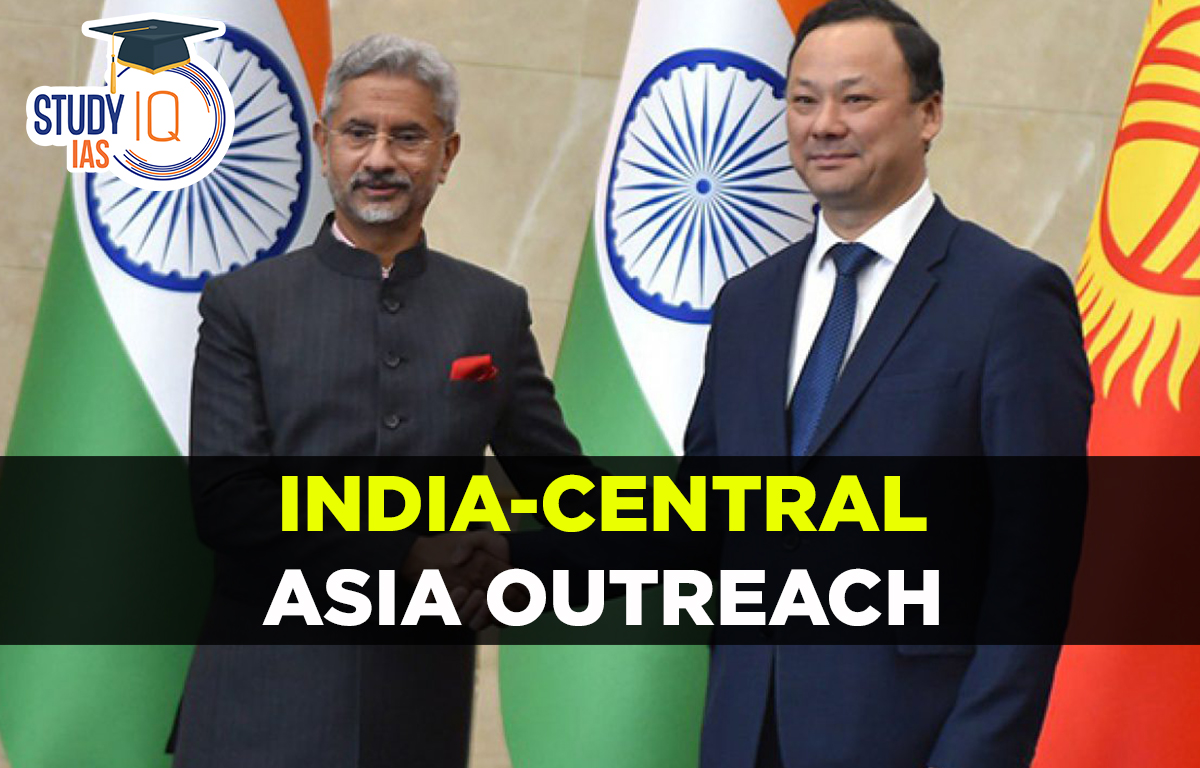Table of Contents
Participating Nations: Kazakhstan, Kyrgyzstan, Tajikistan, Uzbekistan, and Turkmenistan
India-Central Asia Engagement
- Shanghai Cooperation Organization (SCO): It provides New Delhi with a forum to establish security relationships with central Asian Countries.
- India SCO presidentship in 2023 could grant New Delhi the leverage to shape next year’s agenda to prioritize interregional connectivity and shared economic issues.
- First India-Central Asia Summit: In January 2022, Indian Prime Minister Narendra Modi presided over the India-Central Asia Summit with all five Central Asian heads of state present.
- It demonstrated India’s commitment to its “Extended Neighborhood Policy”.
- Objective: To diversify its geopolitical partners and diplomatic goals, and its willingness to engage its Central Asian partners on a multitude of fronts.
- Outcome: To hold a leaders’ summit every two years;
- Joint working group on Afghanistan;
- Joint counter-terrorism exercises between India and interested Central Asian countries.
- A group to operationalise the use of Chabahar port by all five countries.
Significance of Central Asia Region
- Old cultural links: The Silk Route connected India with Central Asia from the 3rd century BC to the 15th century AD.
- Export of Buddhism to the lasting influence of Bollywood, India has shared old and deep cultural ties with the region.
- Counter China’s influence in the region: China has a direct border with the region, with a bilateral trade of $50 billion with Central Asia.
- China has made major investments in these countries with its Belt and Road Initiative.
- Plans for connectivity with Europe including the International North South Transport Corridor (INSTC).
- Counter-Terrorism: India hosted the joint anti-terror exercise under the SCO’s Regional Anti-Terrorist Structure (RATS) with Kazakhstan, Kyrgyzstan, Uzbekistan, and Russia participating.
- It affirms the India-Central Asia security partnership and contributes to India forging comprehensive partnerships across Central Asia.
- Security cooperation after the Taliban takeover in Afghanistan.
- Central Asia is extremely rich in mineral and natural resources: Kazakhstan has one of the biggest reserves of uranium, besides stores of coal, lead, zinc, gold, and iron ore.
- Kyryz Republic is rich in gold and hydro-power.
- Turkmenistan has one of the world’s largest reserves of natural gas (TAPI gas pipeline).
- Tajikistan has huge hydro-power potential.
- Uzbekistan has gold, uranium, and natural gas.
Challenges to India-Central Asia Region
- Lack of overland transport access: Pakistan is blocking the Indian land connectivity in the region is a major challenge to India’s Central Asia plans.
- India wants to integrate the INSTC with Chabahar port in Iran to access the resource-rich region.
- Extremism, Terrorism & Radicalisation: Central Asia is seen as the northern boundary of the Islamic world, and with the Taliban’s return in Afghanistan, the threat of radicalism and possible regrouping of the Islamic State poses a serious security challenge for the countries in the region.
- Strategic Vulnerability: Russia’s war in Ukraine and the Taliban takeover in Afghanistan have exposed the geopolitical vulnerabilities of the landlocked Central Asian states.
Way Forward
- India as a consistent partner to Central Asia: Joint counterterrorism efforts allow New Delhi to flex its security capabilities in the region and monitor its adversaries from a closer range.
- Creating Multilateral Format: It would give India a better launching point for further engagements with its Central Asian partners.
- United States interfaces with the Central Asian countries through its C5+1 multilateral format.
- Japan introduced the “Central Asia plus Japan” dialogue in 2004 to strengthen its diplomatic and economic cooperation with the region.
- Technological Cooperation: India should promote itself as an entrepreneurial hub to its Central Asian counterparts.
- India boasts more than 38,000 officially recognized start-ups and has risen to become the third-largest source of tech start-ups globally.
- India could use its position as a technology hub to network its nascent tech entrepreneurial sector with that of Central Asian countries.
- Air Corridors: India can promote the establishment of air corridors with Central Asian states to facilitate the movement of people and goods between the subcontinent and Central Asia.
- Medical Tourism: It can encourage greater connectivity between India and Central Asia and further medical information exchanges and training.
Conclusion
- In June 2002, the then Prime Minister Vajpayee had said in Almaty that the new “Silk Route Initiative” of India’s foreign policy seeks to build a new Silk Road of Friendship and Cooperation between India and Central Asia.
- India must forge links with this dynamic region via transit, trade, investment, and people-to-people connections in order to cement New Delhi as a reliable and long-lasting partner in Central Asia amid geopolitical challenges.


 Daily Quiz 05 July 2025
Daily Quiz 05 July 2025
 SSC MTS Apply Online for 1075 Posts – ...
SSC MTS Apply Online for 1075 Posts – ...
 Dynamic Pricing: What It Is and Why It's...
Dynamic Pricing: What It Is and Why It's...





















